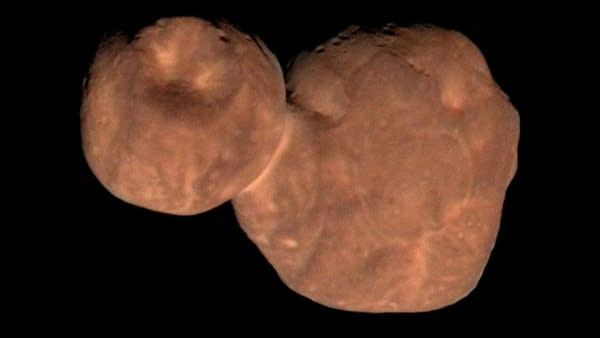What cosmic object 'Arrokoth' can tell us about our solar system's formation

A new study from researchers at the Southwest Research Institute has unearthed a fascinating discovery about Arrokoth, a trans-Neptunian object made famous by the New Horizons probe on New Year’s Day in 2020.
It would appear that the two lobes of Arrokoth are dotted with mounds, each about five kilometers (3.1 miles) across. Those mounds, which give the lobes a slightly raspberry-like appearance, share roughly the same shape, size, color and albedo (how reflective the material is). Such similarity strongly indicates the mounds are disparate objects of a common origin that clumped together at some point to form large parts of the two lobes of the entire 18-kilometer wide (11.2 miles) body of Arrokoth.
"It's amazing to see this object so well preserved that its shape directly reveals these details of its assembly from a set of building blocks all very similar to one another," Dr. Will Grundy, a co-investigator of the New Horizons mission from the Lowell Observatory, said in a statement.
Related: Meet Arrokoth, the most distant object ever explored
Arrokoth is a planetesimal in the Kuiper Belt, a vast stretch of space beyond Neptune that holds remnant building blocks of the solar system leftover from our cosmic neighborhood's formation. Because such planetesimals are believed to have slowly come together and eventually form the planets we see today, scientists are quite interested in studying these objects' characteristics.
The two lobes of Arrokoth, the team realized, are strongly suggestive of a "streaming instability model" of formation, where very gentle collisions, occuring at essentially walking speed, allow smaller objects to accumulate into larger ones. The new research opens up new questions though, primarily around the nearly uniform "building blocks" that make up the individual lobes.
"Similarities including in sizes and other properties of Arrokoth’s mound structures suggest new insights into its formation," said Alan Stern, principal investigator of the New Horizons mission and lead researcher on a new study about the discovery, said in the statement. "If the mounds are indeed representative of the building blocks of ancient planetesimals like Arrokoth, then planetesimal formation models will need to explain the preferred size for these building blocks."
Stern recently presented the paper at the 55th Annual Division for Planetary Sciences meeting in San Antonio.
RELATED STORIES:
— NASA extends New Horizons mission through late 2020s
— NASA celebrates New Horizons' historic Pluto flyby in 2015 with awesome new videos
— New Horizons Pluto probe notches 3 new discoveries in outer solar system
These findings actually bolster the streaming instability model in the first place, suggesting that objects gently accumulated to form Arrokoth at minimal collision speeds in a specific region of the solar nebula undergoing gravitational collapse. "The mounds' uniform sizes and attributes could redefine the very understanding of Arrokoth's formation," Stern said. He emphasized that if these mounds indeed mirror the building blocks of ancient planetesimals like Arrokoth, scientists might need to rethink theories about planetesimal formation in general.
With missions like NASA’s Lucy targeting Jupiter’s Trojan asteroids and ESA’s comet interceptor on the horizon, there is bound to be a lot more interest in how these objects are composed. Like Arrokoth, the subjects of those endeavors are planetesimals left over from the earliest days of the solar system.
"It will be important to search for mound-like structures on the planetesimals these missions observe to see how common this phenomenon is, as a further guide to planetesimal formation theories,” Stern said.
A paper on these results was published Sept. 26 in The Planetary Science Journal.